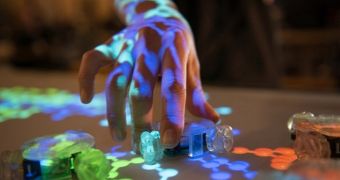Touch-based interaction is all well and good, but sometimes it's hard to really carry out certain tasks without some sort of physical controls. PattenStudio has come up with a new and unusual way of bridging the gap.
This seems to be the week of uncanny solutions to age-old problems. First, someone invents a new way to interact with smartwatches, and now there’s a new method for combining touchscreens with physical controls.
Or, rather, PattenStudio has figured out how to give a touchscreen those physical controls that may be required.
Basically, the studio has invented some small robots, robot Thumbles to be specific, which work with both touchscreen surfaces and projected interfaces.
They can act as knobs, dials and buttons, and essentially replace game controls or keyboards, even mice, when you're looking through a map or 3D model of a building.
We can definitely see a variation of these robots used in the future, whenever someone figures out how to create actual holograms. But that's neither here nor there.
The PattenStudio robot Thumbles can work alone or together, depending on what sort of peripheral they are filling in for.
A single bot can work as a dial, or a slider, but 26 of them could become a large keyboard (if you have enough of them on hand anyway).
Another example is when three of them roll into position, prompting a color corrector to activate and turn them into red, green and blue dials.
The robots “roll” onto the touchscreen, but have moving parts that simulate the functions of other machine-human interaction devices.
Furthermore, they have batteries, so you don't need to be concerned about tripping over wires or anything like that.
Obviously, the PattenStudio Thumbles will have to be made smaller than they are right now if they are to truly replace keyboards. Then again, making them smaller would also render them troublesome to hold and turn with your fingers, which goes pretty much against the whole idea of hand comfort and ease of use.
We may as well just stick to tapping and swiping the screen instead of making the bots smaller than they are right now. Some design refinements and a better sealed plastic casing might be in order though, maybe some visual enhancements to round things up.
Anyway, we can imagine chemists using the Thumbles to manipulate virtual molecular sequences. That's actually one of the operations used in the demo video embedded below.

 14 DAY TRIAL //
14 DAY TRIAL // 